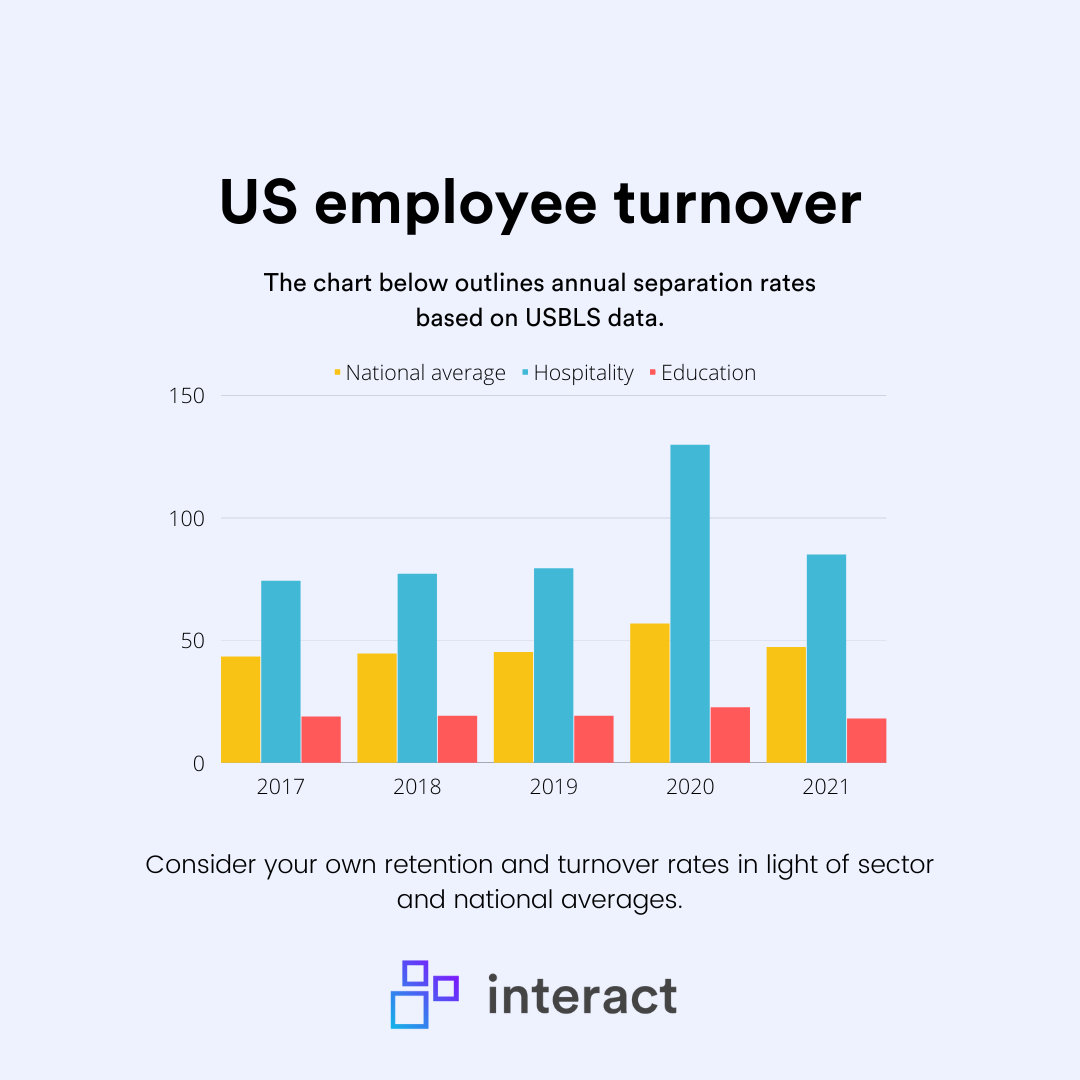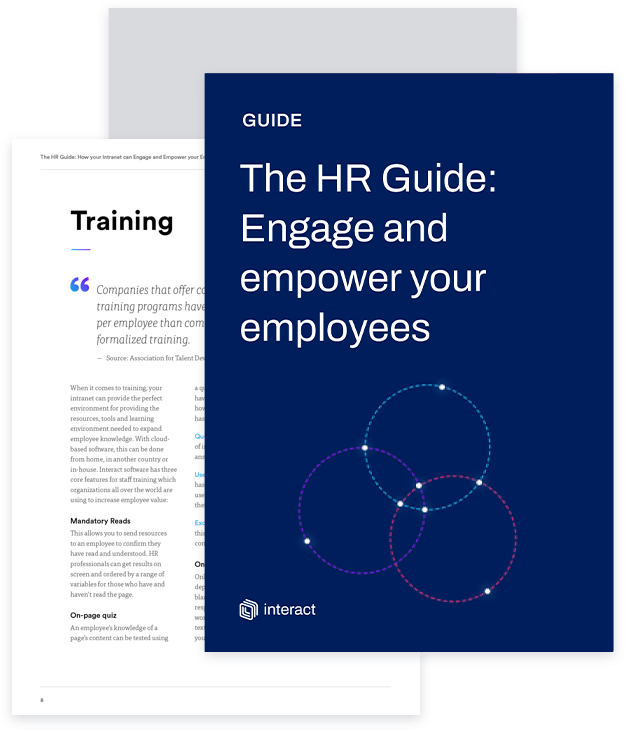No one understands the importance of effective and innovative employee retention strategies like HR. They know that skilled employees are the backbone of every organization, so it’s their role to plan how to retain top talent for the long term. If you are looking for ideas to improve staff retention, read on.
While talent acquisition is one critical dimension of a successful business, keeping hires happy and productive requires another strategy entirely. This is especially true in light of the recently ended Great Resignation, which has demonstrated how easy it can be for organizations to lose individuals and experience a rapid knowledge drain.
Data from the Bureau of Labor Statistics states that the median number of years that most people stay with their employer is 4.1 years, as of January 2022. And that length hasn’t really shifted for over two years. Long-term employees bring a wealth of organizational knowledge and understanding. They comprehend business expectations, often have irreplicable relationships with customers, and know their teams inside out.
A workforce with many long-term employees can also be an excellent example of a thriving culture with rewarded and highly satisfied people. A quick look at the Fortune 100 Best Companies 2022 shows Cisco Systems at the top, with nearly 40,000 global employees. And despite the Great Resignation and the fluctuations of the world around us, they kept their staff attrition rate to 9% annually, much lower than the average 19% within the IT industry.
Cisco’s Chief People Office, Francine Katsoudas, attributes this success to their overall employee satisfaction strategy.
“When our people are taken care of, when they feel heard and included, when they can use their strengths and grow, our company thrives,” Francine said.
Cisco Systems has a lower-than-average staff turnover rate – keeping long-term staff happy – and is judged one of the world’s best workplaces.
Free HR Guide to engaging employees
In organizations with a high turnover and burnout rate, commercial results may still be good but there can be a negative impact on company culture and employee satisfaction. High staff attrition suggests dissatisfaction and a dip in team morale. It needs to be tackled quickly.
What can be done to increase a company’s retention rate? From years of experience speaking with peers and working in HR, I’ve outlined some innovative employee retention strategies below. Hopefully, they will help keep your employees happy and your recruitment costs low.
What is employee retention and why is it important?
Employee retention is the process of encouraging individuals to stay within an organization rather than actively seeking a new role elsewhere. Recently, this idea has been expressed through the prism of employee experience. The argument goes that if we can improve employee experience at every stage of an employee’s journey (from hiring through to onboarding and beyond), they are more likely to progress within the company.
Higher employee retention has multiple benefits, including:
1. Decreased hiring costs
Continual rehiring – especially for highly skilled roles in a competitive market – is time-consuming and expensive. There are job advertising costs, background checks, pre-employment tests, signing bonuses, relocation expenses, and more! Invest that money into your existing employees and keep them loyal.
2. Retain employee knowledge
Don’t let all that valuable knowledge be lost to a competitor. Appreciate knowledgeable employees and focus on retaining them rather than having to train new hires. Building a highly skilled and effective team, and keeping them happy, means you can reap the benefits of their talents and relationships for years to come.
3. Improved overall morale
Morale is lower in a high-turnover business, as teams don’t have those stronger bonds. It can also be disruptive when new employees need training or when individuals work differently from their predecessors. Some turnover is expected and necessary for businesses to grow, but if it becomes excessive then your other employees (and people considering joining your organization) may start to wonder why.
4. A consistent customer experience
If an organization has high turnover rates, it doesn’t take a long time for customers to notice. Keep it going too long and this may give them cause for concern. Similarly, new employees won’t have that pre-existing relationship with customers, which can be invaluable. When learning the role, they may take longer to complete tasks or operate in a less effective way, which can damage the customer experience.
5. Optimized revenue
Gains in revenue come from reduced hiring costs, higher productivity, and the increased level of customer service provided by happy staff. Keeping a measure of this metric provides a general idea of the return on investment for your employee retention strategy, and how it is financially benefitting the organization. You should also keep track of your employee retention rate.
What is a good employee retention rate?

Retention rates are typically measured as a percentage, by the proportion of employees with a specific length of service vs. the overall number of employees within the workforce.
Retention rates are often calculated on an annual basis but can be done quarterly or even monthly. After deciding on your time measurement, divide the number of employees that stayed with your company through that period by the number employed on that first day. You then multiply the number by 100 to get your percentage. Do not count employees hired within the period, only those that worked from day one.
Here’s an example:
You had 150 employees on January 1, 2022, and 120 on December 31, 2022. To work out the retention rate, divide 120 by 150 and multiply by 100. (120/150) x 100 = 80% annual retention rate.
90% should be considered a high rate of employee retention, which makes 10% of staff leaving your business a threshold you may not want to exceed if you want to keep staff for the long term.
Retention rates vary widely by industry and location, and it can be difficult to understand and benchmark how you are performing against others within your sector. Is your employee retention good? Without knowing detailed data about your competitors, there is no way to know. Or is there?
Understanding employee turnover rates
One way to approach this without relying on questionable internet statistics is to think about employee turnover (or separation rates) as an approximate inverse of retention.
It should be noted that the two rates are not exact opposites and the formulae used to calculate them operate differently. However, your employee separation rate (through retirement, relocation, quitting, and involuntary turnover) and your retention rate may generally correlate. While they may not add up to 100%, a retention rate of around 80% annually may link to turnover of approximately 20%.
This is important to know because turnover data is easier to track than retention, especially in the US, where it’s compiled by the Bureau of Labor Statistics. Knowing this, you can use your retention rate to approximate turnover (if you don’t track that separately) and then understand how you compare to your industry.
Employment data from recent years suggests that the average employee turnover rate in the US is between 40% and 50% (putting retention around 60% and 50%). Turnover in industries such as leisure and hospitality is much higher though (84.9% in 2021), while State and local educational organizations had a lower turnover rate of just 18%. While they don’t match entirely, it’s much easier to understand how many more employees are staying for a longer time across different sectors.

Why do staff leave their jobs?
Employees leave roles for multiple reasons, including family commitments, sickness, or retirement, and we do not have control over these decisions. Therefore, it’s almost impossible to have a fully retained workforce. However, retention programs exist to ensure multiple employees don’t quit their jobs, leaving teams scrambling for replacements and HR teams stressed with recruitment responsibilities.
This is where innovative employee retention strategies can really kick in.
Losing top talent is never good for any organization. It affects staff morale, the business loses knowledge gained over their tenure, and it gets expensive when trying to find replacements. Investing in retention prevents this situation by focusing on personal development, meaningful work, and a greater sense of employee enablement.
5 employee retention strategies to try
Not everyone is a perfect fit for your organization, but many will pass probation with flying colors. Give those who do an employee experience that keeps them happy for the long term with these five innovative ways to retain staff.
1) Create a culture of recognition
Within any organization, creating an environment of employee appreciation and peer-to-peer recognition can be one of your most powerful employee appreciation strategies. It can provide quick and fruitful returns but is still underutilized by many organizations. The Gallup-Workhuman Workplace Recognition Study 2022 found that only 36% of employers have any form of recognition system for their employees, with only 21% receiving any monetary value for recognition.
Individuals who feel their employer’s recognition strategy meets their needs are seven times more likely to be actively engaged within their workplace. So, it’s clear that employees need to have more than a simple paycheck. After all, they could get that anywhere. While you may be tempted to invest in an expensive new platform, the solution may already exist within your intranet. Many intranet software providers enable team members to recognize one another through enterprise social network tools. Using an intranet in this way can maximize your return on investment and reduce the need for additional software.
Free HR Guide to engaging employees
It’s important to recognize individual preferences when setting up any recognition system. Some will prefer public acknowledgment from a senior-level employee; others may prefer a monetary token that can be redeemed in a way that suits them. Avoid putting people into boxes and encourage managers to find out what recognition works best for their teams.
2) Encourage a transparent leadership team
The best leaders are aspirational and communicative with their employees. They explain both good and bad business decisions and are accountable for both. A strong business foundation can only be made when the leadership team is trusted and connected to those below them. Your internal comms strategy builds up this relationship so that employees feel reassured during any organizational changes.
But not everyone manager or business leader will be the kind of communicator who takes everyone with them and makes them want to stay.
Bad managers with poor communication skills can be a leading cause of employee turnover. A 2020 study by the Society for Human Resource Management found that 84% of US workers said their manager created additional stress for them, as well as unnecessary work. And an unhappy employee with poor leadership is unlikely to hang around for too long. Tackle these issues when thinking about your employee retention strategies.
3) Be open to honest feedback
Employees are happier in work environments where they have a voice. And HR professionals know better than anyone the importance of discussing issues within teams before they are left to fester and can become a reason for turnover. Honest discussions, and actionable tasks resulting from those conversations, can nip any divisive subjects in the bud.
Employees deserve to feel like they are being listened to by the organization. Whether that is something as simple as a suggestion for a new employee benefit or having a place to voice negative feedback about a particular aspect of their role. Listening to your employees makes them feel like they matter and may be more likely to improve staff retention.

One way of gathering employee sentiment is by using Pulse Surveys. Anonymous and tailored (if necessary), such surveys provide a relevant data point to create and track improvements in how individuals feel about the company. Using an Employee Net Promoter Score (eNPS) survey can ensure your organization has the answers it needs. Insights like this are invaluable when getting a handle on your employee retention strategies.
4) Invest in training and growth
Never underestimate the importance of training your employees – even if they have been with the organization for many years. Learning and development are crucial elements of employee retention; without them, employees are at risk of stagnating or worse. Studies show that 70% of employees would be open to leaving their current role for someone who invested heavily in employee L&D.
A simple way to improve employee experience is to ensure that any Learning Management System (LMS) you use to promote personal development integrates with the rest of your digital workplace. Fast links to an LMS from your intranet homepage will provide a simple UX-led journey for employees, whether they’re using desktop computers, corporate kiosks, or mobile apps.
5) Communicate benefits to everyone
Benefits such as work flexibility, salary, and a rewards package will always be critical factors in retaining the best employees, but you must internally communicate them too. Some employees may be entitled to benefits they are unaware of, like compensated travel costs, work-from-home options, or new equipment.
Everything on offer to your employees, whether there is a monetary value or not, should always be promoted in your communication strategy. The chances are that it will matter to someone.
Although we are in a period of global economic downturn, there is always a market for talent with in-demand skills. And if your employees don’t feel satisfied within their current environment, you may risk losing them.
Luckily, with the use of intranet software and some innovative employee retention strategies, your organization will be able to hold on to valued employees by boosting their job satisfaction and connecting them to your culture. It will also be a crucial tool for understanding how to create company values that resonate with your employees.


